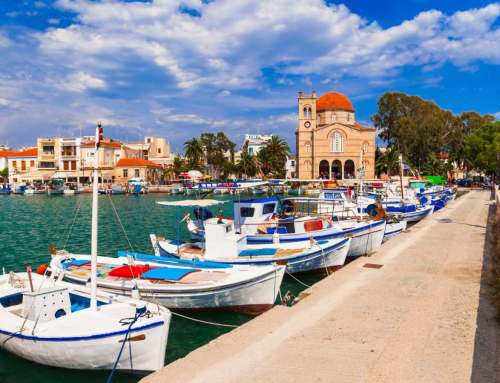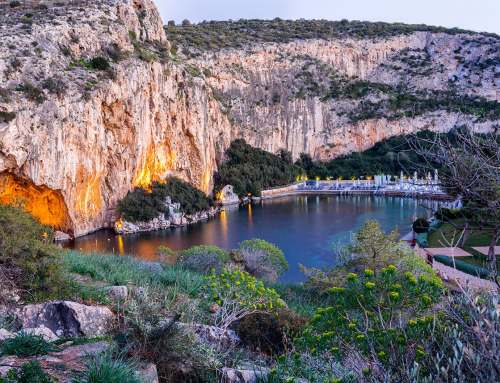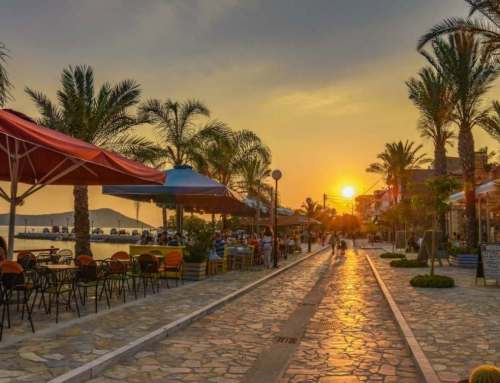Destinations / Athens/ Cape Sounion

Destinations Attica Cape Sounion Epos Travel & Tours
Cape Sounion is the promontory at the southernmost tip of the Attic peninsula, 8 kilometres (5.0 mi) south of the town of Lavrio (ancient Thoricus), and 70 kilometres (43 mi) southeast of Athens. It is part of Lavreotiki municipality, East Attica, Greece.
Cape Sounion is noted for its Temple of Poseidon, one of the major monuments of the Golden Age of Athens. Its remains are perched on the headland, surrounded on three sides by the sea.
Destinations Attica Cape Sounion Epos Travel & Tours
The sanctuary of Poseidon
Destinations Attica Cape Sounion Epos Travel & Tours
The history of the sanctuary Sounion, the sacred point of the Athenians (Odyssey, c 278)
Homer testifies to the sacredness of the area at least from the 8th century BC. In the archaic period (7th- 6th cent. BC) the sanctuary was thriving, though lacking monumental arrangement. Plenty of votive objects were found buried in depositors, gathered there following the destruction of the sanctuary by the Persians in 480 BC. At the end of the archaic period construction of a monumental temple of limestone began, which was destroyed by the Persians before being completed.
The temple was rebuilt on the foundations of the previous one around 444-440 BC. In the classical and hellenistic times (5th – 2nd cent. BC) the sanctuary was frequently visited. A grand four-yearly festival was organized, officials sailing there in a sacred ship, as in the sanctuary on Delos island. With the decline of Greek religion the sanctuary was abandoned and the temple gradually decayed.
Destinations Attica Cape Sounion Epos Travel & Tours
The buildings of the sanctuary
Destinations Attica Cape Sounion Epos Travel & Tours
The sacred precinct of Poseidon, occupying the highest area in the fortress, is defined by a wall except for its south precipitous side, on a surface of around 5000 m2. It was entered through a monumental gateway at the NE. The most important building is the temple of Poseidon, in the south part, while the NW part is occupied by the big north portico and the smaller west one.
Destinations Attica Cape Sounion Epos Travel & Tours
The temple of Poseidon
Destinations Attica Cape Sounion Epos Travel & Tours
The doric temple seen today was built of local marble from the Agrileza quarries on top of the destroyed archaic temple. Palmette antefixes crowned the gable roof. At least the east pediment (on the entrance side) was decorated with statues. On the same side a relief frieze was running on the top of the interior of the colonnade. On the Parian marble frieze slabs scenes of the Centaur battle and the deeds of Theseus are sculpted, an allegory for the victory of the Greeks led by the Athenians against the Persians and for the superiority of the Athenian democracy over the eastern monarchy. The temple is attributed to the same architect with the ones of Hephaistos (?Theseion?) at the Athenian agora, Ares at Akharnes and Nemesis at Ramnous.
Destinations Attica Cape Sounion Epos Travel & Tours
The fortress: The wall
Destinations Attica Cape Sounion Epos Travel & Tours
The city – state of Athens fortified for safety reasons at its frontier several sites of strategic importance, among which cape Sounion.
The walls extend to a length of about 400 m on the north and east sides, cutting off the cape from the land. They enclose an area of about 4 ha occupied by the sanctuary of Poseidon and a settlement of the deme of Sounion. They are not of a uniform quality, since through time they underwent several repairs and alterations following the defense needs.
The wall, 3 – 3.5 m wide, is built of two parallel fronts, with a fill of stones and soil. On the inner side, two stairways leading to the upper part of the wall were revealed. The entrance gate is located on the NW, accessible from the port.
Destinations Attica Cape Sounion Epos Travel & Tours
The settlement
Destinations Attica Cape Sounion Epos Travel & Tours
A settlement extends on the better part of the area inside the fortress. The main feature is a street, 3-3.60 m wide and 100 m in revealed length, climbing up the slope from W to E. On both sides of the main street and perpendicular to it, narrower streets formed regular blocks (30 X 30 m).
Four houses must have formed each block only partially exposed. The settlement housed the garrison. However, the lay-out, the type of houses and the movable finds suggest that it was the centre of the Sounion deme.
It endured for a long time and the buildings underwent several repairs and transformations. The phase now visible belongs to the Hellenistic period (end of 4th and 3rd cent. BC).
Destinations Attica Cape Sounion Epos Travel & Tours
The port and the ship sheds
Destinations Attica Cape Sounion Epos Travel & Tours
The port of Sounion was located at the sandy cove north of the fortress, protected from north winds. It was an advanced naval base of the Athenians, but also a commercial station. Commercial ships could be hauled on the sandy beach, while for the maintenance and keeping of warships ship sheds had been built.
A ship shed for two ships was cut out on the rocky shore at the cove entrance. It is a rectangular alcove, 11.50 m wide, penetrating the slope for 20.50 m. Along the floor, cut out at a slant, two parallel trenches 1.25 m deep were dug out, suitably arranged for hauling and launching the ships. Another ship shed for one ship is located a little further to the E.
Destinations Attica Cape Sounion Epos Travel & Tours
The sanctuary of Athena at Sounion
Destinations Attica Cape Sounion Epos Travel & Tours
The top of a low hill about 400 m to the NE of the sanctuary of Poseidon is occupied by the sanctuary of Athena. A trapezoid enclosure of limestone (about 46.50X44 m) runs around the flattened top of the hill and defines the sanctuary with the temple of Athena, the small temple and the depositor. Right to the north, an older sacred precinct is located, the so precinct of “Phrontis”. The temples of the sanctuary were deconstructed, as usually practiced in the roman period with the abandoned temples in the periphery, and transported to adorn the Athenian agora.
At the temple of Athena the cella was bordered by a colonnade only on the east and south sides. The marble columns were unfluted, with ionic capitals. In the back of the cella the foundation of the pedestal for the cult statue is preserved. The altar is placed south of the temple, apparently because the spacious plateau at the south was suitable for the worshipers to gather and for the offerings to be placed. The temple was built around the middle of the 5th cent. BC. According to another view, it predated the Persian wars and only the exterior colonnades were added.
The small temple (4.96X6.80 m) is located at the NE consisting of a cella with two columns in the front. In the back the base for the cult statue is of grey marble of Eleusis. Opposite the main side the altar is located. The temple was probably dedicated to the goddess Artemis. It dates to the archaic period (600-500 BC) and was destroyed by the Persians (480 BC). According to another opinion it is contemporaneous with or later than the big temple of Athena.
Destinations Attica Cape Sounion Epos Travel & Tours
The depositor
Destinations Attica Cape Sounion Epos Travel & Tours
In the SE area of the sanctuary there is a wide trench 15 m deep accessible through 15 hewn steps. The initial use remains obscure. Later, probably after the Persian wars, the old offerings were deposited in it. They date from the 9th to the mid 5th cent. BC, when the trench was covered.
Destinations Attica Cape Sounion Epos Travel & Tours
The precinct of “Phrontis”
Destinations Attica Cape Sounion Epos Travel & Tours
At the NW part an almost circular wall of roughly hewn large stones defines a precinct older than this of Athena. In the precinct, apparently a sacred grove, a hero was worshipped, probably Phrontis, the helmsman in Menelaus’ ship during the return from Troy to Sparta, who died and was buried at Sounion (Odyssey, c 276-285).
The old precinct and the depositor with the oldest of the finds evidence a most ancient cult that had started in the area of the Athena sanctuary.
Author
Dr Eleni Andrikou, archaeologist






